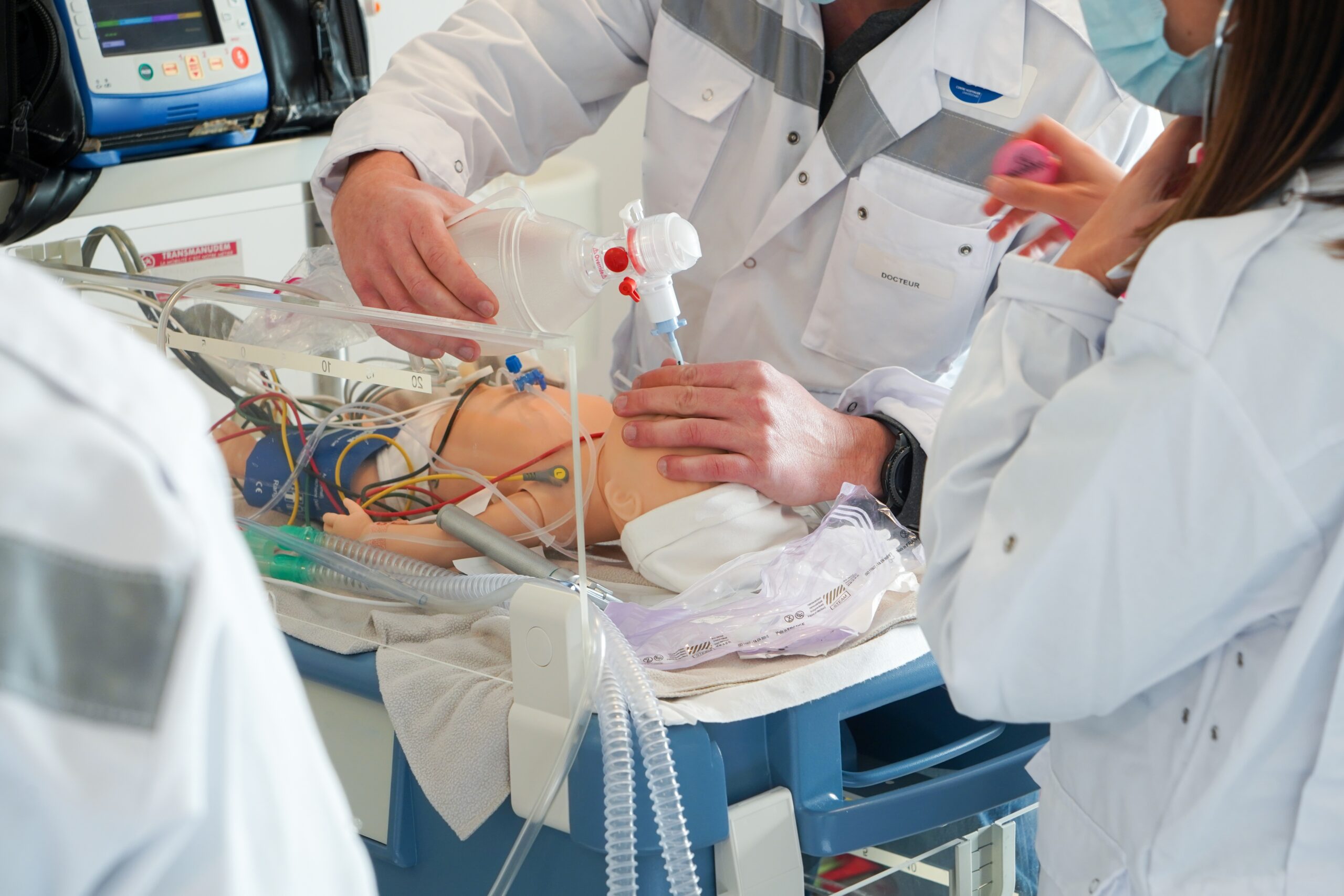
RT Needs More Educators! Could You Be One of Them?
By Debbie Bunch
March 4, 2024
The respiratory care profession would not exist without dedicated educators to prepare each new generation of therapists. The current shortage of therapists overall coupled with an aging educational workforce, however, is calling that future into question.
Bottom line, the profession needs more therapists to step up into faculty positions at colleges and universities across the country. In the following interview, four leading RT educators — Sarah Varekojis, PhD, RRT, FAARC, Kristen McHenry, EdD, RRT, RRT-ACCS, Jennifer Anderson, EdD, RRT, RRT-NPS, FAARC, and Kimberly Clark, EdD, RRT, FAARC, FNAP — share their insights into the problem and what RTs with an interest in entering the educational setting need to know before taking the leap.
What is the current state of the educator workforce in respiratory care and how and why is this projected to change in the coming years?
Dr. Varekojis: According to the 2022 CoARC Report on Accreditation, there are 466 respiratory therapy programs or program options accredited by CoARC. All of these programs are required to have a program director, and 430 are required to have a director of clinical education as well. Many programs also have additional full-time and part-time faculty that provide education in the classroom, laboratory, and clinical environments.
In 2022 CoARC approved approximately 30 new respiratory therapy programs as well, and all of these new programs need educators. CoARC continues to receive applications for new education programs and program options too.
CoARC also tracks how many changes in program director and director of clinical education positions occur each year, and there were approximately 95 changes in program director and 145 changes in directors of clinical education in 2022. Some of these changes were due to retirement, some were due to promotions, and some were due to exploring other opportunities. Regardless, these circumstances combine to create lots of opportunities in RT education. You do not have to look very long on the job boards on CoARC.com or AARC.org to see postings for program directors, directors of clinical education, and faculty throughout the country.
There are also many opportunities for RT education within hospitals and health systems. Hospital-based educators are needed to coordinate new employee orientation, provide peer education and competency assurance, coordinate with RT education programs to provide clinical education to students, and more. Both the CoARC and AARC job boards include these opportunities as well.
As with many specialties within respiratory therapy, a significant number of RT educators are at or nearing retirement age. It is expected that there will continue to be abundant opportunities for RTs interested in an education career path for the foreseeable future.
An advanced educational degree is a must for most if not all educational positions. Can you tell us more about what levels of education are needed and how these levels may vary depending on whether the program in question is at the Associate’s degree level or the Bachelor’s degree level?
Dr. McHenry: Higher education faculty typically must hold a degree higher than what they teach. For instance, if teaching at the Associate level, a minimum of a Bachelor’s degree is required, and likewise for teaching at the Bachelor’s level a Master’s degree is required and at the Master’s level a doctorate is required. This is mandated by both regional accreditors and discipline-specific accreditors, like CoARC.
However, there are instances where faculty may qualify to teach based on demonstrated competence within the discipline. The knowledge and skills of the faculty member should be matched with the appropriate content areas within the curriculum. It is not uncommon for instructional or part-time faculty to be considered qualified based on the attainment of specialty credentials, years of experience, or a current clinical role in a specific content area. Some faculty are hired as “transitional’ until they obtain the required degree, which is only approved for a predetermined timeframe — usually no more than two years.
Dr. Anderson: Please also note that many institutions have regional accreditation standards as well, and these vary, so make sure to check the regional accreditation standards at the institution you would like to teach at, especially if you are looking to teach full-time. Specifically, be aware that educational institutions may require you to have at least 18 graduate semester hours in respiratory therapy courses in order to teach.
You can get an idea of what these regional standards look like by reading through the Faculty Credentials developed by the Southern Association of Colleges and Schools Commission on Colleges.
In addition to an advanced degree, RT programs will be looking for therapists with clinical experience and advanced RT credentials. What kind of experience is needed to land a faculty position and which credentials are most important to have?
Dr. Varekojis: If you are interested in becoming a program director or a director of clinical education for an RT program, CoARC has additional eligibility requirements that cover credentials, licensing, clinical experience, and prior teaching experience.
For other full-time and part-time faculty roles, many RT programs will require evidence of expertise in the content being taught. This is likely a combination of clinical experience and NBRC credentials. For example, if you want to teach mechanical ventilation for neonatal patients, you should have both clinical experience in neonatal critical care and the RRT-NPS credential from the NBRC.
You can also demonstrate interest and expertise in teaching by volunteering to provide in-service education, present at a local or state continuing education meeting, precept students, or teach a class or lab to students on a topic of interest to you. These are great places to start, and you can be working on advancing your degree and obtaining specialty credentials in your area of interest as you build your teaching portfolio to demonstrate you have the interest and expertise to become an RT educator.
What are some of the key personal characteristics a person needs to have before embarking on a career in RT education and why are these important?
Dr. Anderson: Some of the key characteristics that are necessary for a person to become an RT educator include excellent communication skills, a passion for teaching, patience, and the ability to work well with others. Effective communication is crucial in RT education because it involves not only delivering information but also listening to and understanding the concerns of students.
A passion for teaching is important because it helps an RT educator stay motivated and enthusiastic about their work, which in turn, can inspire and engage students. Patience is an essential characteristic that an RT educator must possess because teaching can be challenging, and it often takes time and effort to help students grasp complex concepts. An RT educator must be willing to work with students until they understand the material.
Dr. Clark: RT educators must have a desire for lifelong learning too. Motivation to stay current with new advances in the field ensures curriculum content is relevant to practice. In addition, RT educators must be willing to learn best practices in teaching and learning to create engaging and meaningful learning environments.
Like health care technology, education technology is rapidly changing. Staying up-to-date on current education trends and new practices is essential to promote student success.
Lifelong learning can include continuing your formal education to the next degree level or graduate certificates in specific content areas to develop expertise, such as online learning. Professional continuing education is equally important in staying current in advances in education technology and practices.
The AARC offers the Advanced Leadership Institute – Education Track Package to provide foundational education leadership development and advanced topics developed by content experts to provide the latest knowledge on best practices.
What are the biggest challenges, and biggest rewards of working in the RT educational setting and why?
Dr. Anderson: As someone who has worked in the respiratory therapy higher educational setting for a while, I can say that there are both challenges and rewards to this career path. One of the biggest challenges is keeping up with the constantly evolving practices and technologies. It can be difficult to ensure that the material and equipment being taught are up-to-date and relevant to current practices.
There are several other challenges facing higher education today too, including rising costs and student debt, declining state funding for public universities, increasing competition for funding and resources, and the need to adapt to rapidly changing technology and workforce demands. In addition, some programs and institutions are seeing a decline in applications and enrollment and have challenges retaining students. These challenges require innovative solutions and a willingness to adapt and change in order to ensure that higher education remains accessible, affordable, and relevant in today’s rapidly changing world.
The biggest reward of working in this field is the opportunity to shape and inspire the next generation of respiratory therapists. It is incredibly fulfilling to see students learn and grow under your guidance, and to know that you are helping to prepare them for a career that can truly make a difference in people’s lives. Additionally, the sense of community and camaraderie among colleagues and students alike is another rewarding aspect of working in this field. Overall, while there may be challenges, the rewards of working in respiratory therapy higher education are certainly worth it.
What opportunities for advancement does the educational setting offer to RTs?
Dr. McHenry: Instructional faculty or adjuncts can become full-time faculty, full-time faculty can become key personnel such as program director or director of clinical education, and key personnel can advance into other leadership roles within their institutions, such as department chair, associate dean, college dean, and beyond.
Faculty can also advance into other areas such as instructional or curriculum design and serve as independent consultants for program start-ups. Most full-time faculty are eligible for promotion in rank — assistant professor, associate professor, full professor — or the awarding of tenure depending on the institution and appointment track.
Once an educator has a great deal of experience as key personnel and expertise in the accreditation process, they can become site visitors for CoARC. Educators can also serve by teaching credentialing review courses either through a third party or their own company. Leadership opportunities are available through the AARC Education Specialty Section as well.
Top Tips from These Top Educators
Clearly, the educational arena offers a wealth of opportunities for therapists who are willing to put in the work it will take to qualify for a faculty position in respiratory care. Jennifer Anderson, Kristen McHenry, and Sarah Varekojis each gave us their top three tips for success in this setting —
Jennifer Anderson
- Join the AARC Education Section: Network and learn from educators from around the world. The Education Section was organized to connect higher education educators and hospital educators. The AARConnect Education Section page links you to fellow section members. It allows you to communicate directly with educators, ask questions, share resources, and learn.
- Join the American College of Respiratory Therapy Education: The American College of Respiratory Therapy Education was organized to provide academic support to all programs, faculty, and students, with the goal of advancing professional education at all levels.
- Attend the AARC Summer Forum: Designed for respiratory therapy educators and leaders, the Summer Forum includes sessions filled with specially designed lectures and symposiums, along with networking events and an exhibit hall. It is a great way to connect with respiratory therapy educators and leaders from all over the U.S. and beyond.
Kristen McHenry
- Do your homework: Get to know potential institutions, the structure and culture of their programs, the needs of the community, and how you think you could fit in.
- Get a mentor: This may be a previous instructor or colleague, but they can offer valuable insights into the transition into education.
- Make a plan: Success in education requires a great deal of organization and time management so having goals and to-do’s for any given semester or academic year will help ensure you are progressing and meeting the demands of the role.
Sarah Varekojis
- Empathize with your students: Get to know your students and let them get to know you. You are a big part of their lives and they are a big part of yours. Understand their challenges and celebrate their successes. This will lead to immeasurable rewards.
- Ask for help and learn from your mistakes: Don’t be afraid to ask for help. Develop relationships and form a network of trusted people where you can be honest and get advice and new ideas. There are elements of experimentation in education — don’t be afraid to try something new, and if it doesn’t work, learn from it and try again. Adapting teaching methods is imperative for both your success and for the students’ success.
- Always remember your motivation or your “why”: Constantly remind yourself why you chose RT education. You’re not going to get rich, there are going to be more headaches than you anticipate, and there are going to be times when you wonder “why.” Try to keep the successes, the impact you have made, and the lives you have changed on the top of your mind. Hold on to those notes, emails, and texts of gratitude and use them for encouragement and motivation to keep going when you need a reminder of “why.”
To learn more about a career pathway in RT education, visit the MoreRTs.com Respiratory Care Educators page.








